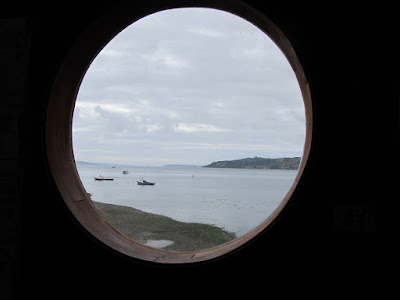From Chiloe the bus drove onto a ferry to cross to the mainland.We drove down the road.
Straight onto the ferry - it was waiting for us.
The ferry line is owned by the same company at the bus line!
Where have all the mountains gone? The scenery is all flat now!
Puerto Varas is like stepping back in time! during all the upheavals in Germany in 1850's (before Germany was united as a country) many families emigrated to Chile. At that time the Chilean Government needed people to develop the land. The German's came mainly from Bavaria. We had noticed for some time that the houses were looking very 'German' in structure, but arriving in Puerto Varas we felt we had arrived in Germany! We arrived in time to enjoy the local Bierfest!
German traditions are very strong.
Even the local bier label is printed in German!
The church is an exact replica of a church in Bavaria.
The bandstand is a replica of one in Germany.
And the pier too - I'm sure
I'm sure I stayed in a hotel like this in Bavaria with my parents many years ago.
The best hotel looked wonderful.
With a glorious garden - a bit like our friend Margarete's garden.
There was a German gnome to keep everyone happy.
Many notices were in German and Spanish.
WE did admire all the gardens all neatly clipped.
On the front was a grand piano! Tony had to play it!
In the evening we went to a rather expensive restaurant and drank some fabulous wine made from the Carmenere grape. It was thought to be extinct until a German wine maker did some tests on what he thought was a Merlot vine - to his surprise he found it was the lost vine. The vine is flourishing in Chile and they are making some fabulous wines with it. Let's hope we will be able to get some in Europe - we shall have to talk about it in The Wine Society.
All this great meat we are eating makes us wonder if we will look like this gentleman!
The ferry line is owned by the same company at the bus line!
Where have all the mountains gone? The scenery is all flat now!
Puerto Varas is like stepping back in time! during all the upheavals in Germany in 1850's (before Germany was united as a country) many families emigrated to Chile. At that time the Chilean Government needed people to develop the land. The German's came mainly from Bavaria. We had noticed for some time that the houses were looking very 'German' in structure, but arriving in Puerto Varas we felt we had arrived in Germany! We arrived in time to enjoy the local Bierfest!
German traditions are very strong.
Even the local bier label is printed in German!
The church is an exact replica of a church in Bavaria.
The inside was very plain compared to the German Baroque churches.
We decided to take the bus along the lake to what the locals call 'The upmarket lakeside town'
called Frutillar Bajo. Apparently as the Germans became wealthy they built summer houses in this town. It remains as German today as it was in the early 1900's.The bandstand is a replica of one in Germany.
And the pier too - I'm sure
I'm sure I stayed in a hotel like this in Bavaria with my parents many years ago.
The best hotel looked wonderful.
With a glorious garden - a bit like our friend Margarete's garden.
There was a German gnome to keep everyone happy.
Many notices were in German and Spanish.
WE did admire all the gardens all neatly clipped.
On the front was a grand piano! Tony had to play it!
All this great meat we are eating makes us wonder if we will look like this gentleman!





































































































